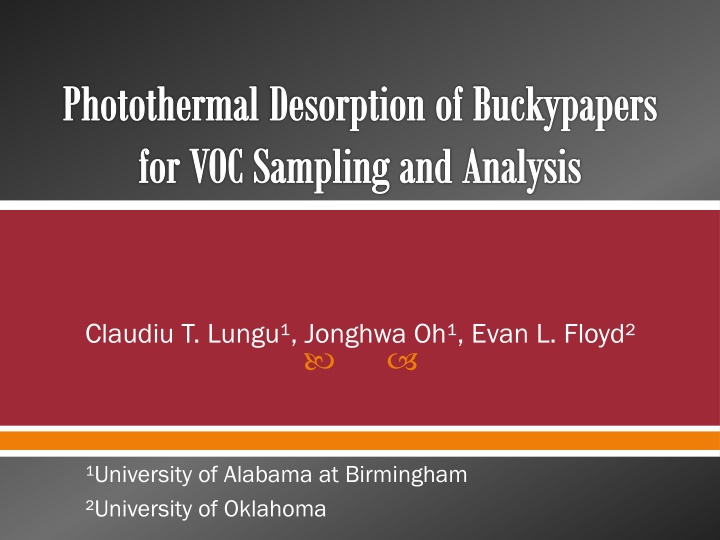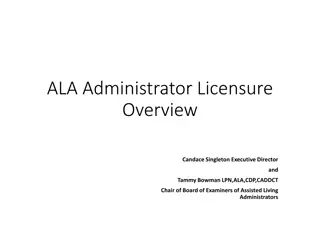
Innovative Photothermal Desorption of Buckypapers for VOC Sampling
"Learn about a novel pre-analysis technique using photothermal desorption of buckypapers for volatile organic compounds (VOC) sampling and analysis. Discover the advantages of this method, such as cost and time efficiency, elimination of toxic solvents, and enhanced sensitivity. Explore the use of carbon nanotubes as a superior sorbent for photothermal desorption. Stay informed about the latest advancements in VOC analysis in various industries."
Download Presentation

Please find below an Image/Link to download the presentation.
The content on the website is provided AS IS for your information and personal use only. It may not be sold, licensed, or shared on other websites without obtaining consent from the author. If you encounter any issues during the download, it is possible that the publisher has removed the file from their server.
You are allowed to download the files provided on this website for personal or commercial use, subject to the condition that they are used lawfully. All files are the property of their respective owners.
The content on the website is provided AS IS for your information and personal use only. It may not be sold, licensed, or shared on other websites without obtaining consent from the author.
E N D
Presentation Transcript
PhotothermalDesorption of Buckypapers for VOC Sampling and Analysis Claudiu T. Lungu , Jonghwa Oh , Evan L. Floyd University of Alabama at Birmingham University of Oklahoma
Outline Introduction Innovation Methods Results & Conclusions Future work & Discussions
Introduction Volatile Organic Compounds (VOCs) o Global atmospheric emission- 1300 TgC/yr o Health concern in many industries using solvents (e.g., painting, spraying, coating, etc.) Exposure assessment for gases/vapors o Conventional sorbent-based sampling o Laboratory analysis
VOC Sampling and Analysis Sampling o Sorbent- activated charcoal/carbon High specific surface area (> 1000 m /g) Affordable (e.g., $ 0.42/g SKC Anasorb CSC) SKC Sorbent Tube Analysis o Chemical desorption Time-consuming ( 30 min) Toxic solvents (e.g., CS or MeCl) Only 0.1 % analyzed in gas chromatography (GC) o Thermal desorption Directly in GC system; traditionally one shot analysis Expensive thermal extraction unit System integrity check (e.g., leak checks) 3M Passive Sampler
VOC Sampling and Analysis Sampling methods o Active sampling Pump- inconvenient Sorbent tube Tubing o Passive sampling Passive badge containing sorbent No pump- wearer acceptance Limited sensitivity by diffusion
Innovation: Novel Pre-Analysis Technique Photo-thermal Desorption (PTD) o A pulse of light, thermally desorbing analyte o An alternative to current VOC analysis Elimination of sampling preparation/analysis time and cost No toxic-solvents used Repeated analysis, desorbing a portion of analyte at once Enhanced sensitivity PTD System - E. Floyd, K. Sapag, J. Oh, C. Lungu, Ann. Occup. Hyg. (2014)
Sorbent for PTD: Carbon Nanotubes (CNTs) Superior electrical, optical, and thermal conductivity o A wide variety of applications (e.g., mechanical, structural, thermal, electrical, biomedical, etc.) Large surface area (300 1,000 m /g) o Can be higher by further fabrication process Single-walled Carbon Nanotubes (SWNTs) o Considered as a prime material for gas sorption o Higher in electrical/thermal conductivity (3000 W/m K) SWNT Thermal conductivity of gold- 300 W/m K
Carbon Nanotubes (CNTs) Synthesis methods of CNTs/SWNTs o Chemical Vapor Deposition (CVD) o Arc Discharge (AD) o High-pressure Carbon Monoxide (HiPco) o Laser Ablation (LA) Buckypaper o A self-supporting form made of CNTs 3M Passive Sampler
Fabrication of BP Three types of SWNTs o Chemical Vapor Deposition (CVD) o Arc Discharge (AD) o High-pressure Carbon Monoxide (HiPco) Vacuum filtration method o Suspension with solvents (i.e., acetone or methanol) o Filtration under vacuum o Additional cleaning/rinsing only for AD SWNTs Suspended in 1 % surfactants of sodium cholate and sodium dodecyl sulfate in water when purchased
Vacuum Filtration Process SWNTs suspended in solvent Membrane filter Vacuum
Types of BPs CVD Felt o No self-supporting form obtained AD BP o Acetone suspension & DI water/acetone cleaning HiPco BP o Methanol suspension & no cleaning
Adsorption Efficiencies Surface area & pore size o ASAP 2020 Physisorption Analyzer o Degassing at 300 C for 1 hr prior to analysis o N adsorption at 77 K (-196 C) Physisoprtion Analyzer Adsorption isotherm (capacity) o Diffusive Adsorption Isotherm Chamber (DAIC) o VOC TRAQ PID (Photoionization Detector) o Toluene as a representative VOC at 30 C DAIC System
Adsorption Isotherms Toluene adsorption capacity at 800 ppm
Results: Adsorption Efficiencies Surface area (SA), mean pore diameter (d) & toluene adsorption capacity AD BP AD BP HiPco HiPco BP BP BET SA (m /g) 322 38 649 3 d (nm) 9.7 0.5 7.7 0.3 Adsorption Capacity (mg/g) 34 106 n=3 for SA & d, n=1 for adsorption capacity Cleaning/rinsing repeated with 250 mL DI water & 50 mL solvent SA determined by Brunauer, Emmett, and Teller (BET) theory - J. Oh, E. Floyd, T. Watson, C. Lungu, Anal. Methods. (2016)
Heat Treatment Thermogravimetric Analysis (TGA) o 10 C/min in air, up to 800 C Heat treatment (HT) Conditions o AD BP: 300 350 C for 60 120 min o HiPco BP: 250 350 C for 30 min TGA Surface area o ASAP 202 Physisorption Analyzer o N adsorption at 77 K (-196 C) Changes in weight and physical integrity (i.e., appearance and surface)
Selection of HT Condition AD BP- 300 C for 90 min o BET SA- 970 18 m /g o 3 times increase (SA before HT- 322 m /g) HiPco BP- 300 C for 30 min o BET SA- 933 54 m /g o 40 % increase (SA before HT- 649 m /g) - J. Oh, E. Floyd, M. Parit, V. Davis, C. Lungu, Journal of Nanomaterials (2016)
PhotothermDesorption (PTD) Desorption efficiencies o Flow: 15 mL/min N o Source: xenon flash lamp o Loading: 864 g toluene vaporized o Light E: 1.84 7.37 J o One pulse administered o Quantification: integration of peak area of PID data Desorption Unit
PID Data HiPco BP AD BP
Results: PTD t-test, p-values <.0081, .0106, .0007 & .0256 at 1.84 3.68, 5.53 & 7.37 J
Conclusions Toluene adsorption capacity proportional to surface area for all tested BPs HiPco BP was more adsorptive before HT but AD BP improved to the similar degree of adsorption properties to HiPco BP after HT AD BP showed higher desorption at all energy levels; potential use for efficient VOC sampling and analysis with PTD
Future work & discussions Further examinations with more precise, elaborated PTD set-up PTD with other VOCs o e.g., polar compounds- through functionalization Prediction of proportional desorption by applied energy after enough data collected Commercialization of PTD technique o BP sorbent, light source & a detector or an analyzer (e.g., PID or portable GC) Development of alternative sorbents to BPs o Biomass derived carbonaceous materials through HTC (Hydrothermal Carbonization) process
Acknowledgements National Institute for Occupational Safety and Health (NIOSH) R21 (#5R21OH010373)






















